This story appeared in the July/August 2020 issue as “Let’s Make Some Memories.” Subscribe to Discover magazine for more stories like this.
Maybe it’s a hazy snapshot of your first time riding a bicycle. Or the ability to recite the Pythagorean theorem. It could be as simple as that phone number you scrawled on a napkin before it landed in the trash.
Whatever shape they take, our memories help define who we are — and what it means to be human. While scholars have been musing on memory since the time of Socrates, new tech has helped today’s scientists learn much more about the neural and biological machinery behind our recollections. These breakthroughs have led to the discovery that our memories reside in specific clusters of brain cells. Some scientists are exploring how people store and retrieve memories as they move through a virtual reality environment. Others are studying how emotions like fear are encoded in the brain, as well as the circuitry that controls what we’re afraid of.
This research isn’t rooted in the abstract, either. The projects are aimed at real-world applications, including possible treatments for conditions such as Alzheimer’s disease and post-traumatic stress disorder.
And while much of memory science is still a blur, the matter of how, exactly, our brains form memories is coming into sharper focus.

(Credit: Evan Oto/Science Source)
The Long and Short of It
The notion of human memory doesn’t refer to any one thing. The term is an umbrella for an array of recollections, from the names of colors to half-remembered song lyrics to your first breakup. So, what are these different types of memory?
Over a century ago, scientists partitioned memory into short-term and long-term categories. Short-term memory, sometimes called working memory, refers to our ability to retain information or events from the recent past — but only for as long as about 20 seconds ago, sometimes even less. In other words, it’s the stuff that you’re actively holding in your head while performing other tasks — for example, remembering a phone number as you scroll around to plug it into your contacts list.
In the 1990s, scientists analyzed high-resolution brain scans and found that these fleeting memories depend on neurons firing in the prefrontal cortex, the front part of the brain responsible for higher-level thinking.
“They are temporary [memories],” says neuroscientist and author Dean Burnett. “It’s not meant to be for long-term storage, because they’re constantly changing and constantly in flux.
“If you hold something in the brain long enough, you can turn it into a long-term memory,” he adds. “That’s why, if you recite something like a phone number, you can eventually remember it quite easily. But if too much stuff keeps coming in, your short-term memory gets overloaded and the first [bits of information] will get kicked out.”

(Credit: Macrovector/Shutterstock; mything/Shutterstock)
By contrast, long-term memory is the treasure trove of knowledge and past events collected throughout our lives. And while short-term memories are supported by blips of neural activity, long-term memories actually forge a physical presence in the brain. When a long-term memory is formed, the connections between neurons, known as synapses, are strengthened. In some cases, entirely new synapses are created. And the more we revisit memories, activating these neural pathways, the stronger the connections become — like trampling your way through the woods to create a well-trodden path.
Long-term memories can also take several different forms. For example, implicit memories are the basis for automatic behaviors like tying your shoes or brushing your teeth. These instinctive actions take place in the unconscious part of the brain. “This is why people with amnesia can still do these things, even if they have no memory of doing them before,” says Burnett. “The training takes hold.”
Long-term remembrances that we’re actively aware of, however, are known as explicit memories. These are split between episodic and semantic memory. The latter describes specific, conceptual knowledge, like the date on which the Declaration of Independence was signed. Episodic memory describes events and experiences from your own life. Everything from your 21st birthday party to your trip to Europe falls into this category.
“Semantic memory is [knowing] that Paris is the capital of France,” says Burnett. “Episodic memory is [remembering] that time I went to France and threw up off the Eiffel Tower.”
Lighting The Way
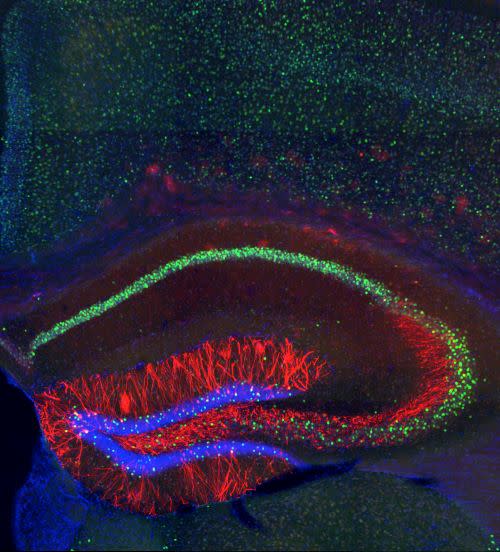
MIT scientists labeled the cells (highlighted in red) where memory engrams are stored in a mouse
hippocampus. (Credit: Steve Ramirez and Xu Liu)
The things we do in life leave traces behind, embedded in our memories. Much like Marcel Proust biting into his much-loved madeleines, causing once-forgotten memories from his childhood to come flooding back, memory traces can conjure vivid sensory experiences of things past. Since the days of ancient Greece, scholars have speculated that these remnants might even alter the physical makeup of the brain.
But it wasn’t until the turn of the 20th century that scientific models of this process began to emerge. In 1904, a German scientist named Richard Semon suggested that these traces, which he called memory engrams, are represented as physical changes in the brain after an event or experience. “At the time, there was no technology to identify those brain cells which hold the specific engram for a specific memory,” says Susumu Tonegawa, professor of biology and neuroscience at MIT and winner of the 1987 Nobel Prize in Physiology or Medicine.
More than 100 years passed. Then, in 2005, scientists started using optogenetics, a technique for stimulating neurons that are genetically modified to respond to pulses of blue light. With this new technology, it was possible to localize and identify the specific neurons that carry memory engrams in animals. In a 2012 Nature study, Tonegawa and researchers at MIT and Stanford University used optogenetics to demonstrate that our memory traces do indeed live in specific clusters of brain cells. Beyond that, merely activating a few of these neurons can recall an entire memory.
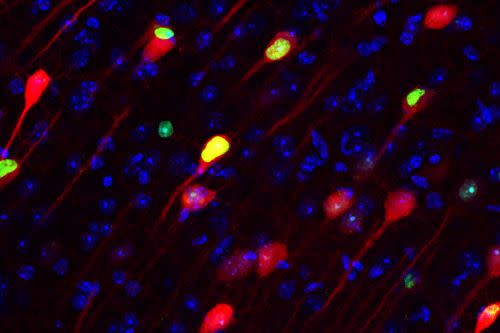
The cells (shown in green and red) are vital for permanent memory storage. (Credit: Takashi Kitamura)
In the paper, the research team describes how they pinpointed a particular group of neurons in the hippocampus, a part of the brain involved in the formation of long-term memories, that start firing under certain conditions. In this case, the researchers did so by having mice explore an unfamiliar cage. “[Then] you give [the mouse] mild electric shocks to their footpads,” says Tonegawa. “And the mouse will immediately form a memory that this cage is a scary place.” The next day, says Tonegawa, when the mice were placed in the cage without being zapped, this conditioning led them to fear that environment. The researchers later injected the rodents with a protein that can trigger brain cells — specifically, the neurons in the hippocampus that the scientists were targeting — by flashing them with blue light. “These proteins have a chemical property to activate cells when light of a particular wavelength is
delivered,” adds Tonegawa.
Then, when the scientists flashed the mice with pulses of light in an entirely different environment, the neurons in the hippocampus they had labeled with the protein sprung into action — and the mice froze in place. The researchers think the animals were mentally flashing back to the experience of being shocked. “That’s the logic of the experiment,” says Tonegawa. “You can tell that these neurons, which were labeled yesterday, now carry those memory engrams.” In other words, even though the memory of the cage was stimulated by artificial means, the mice still recalled it, suggesting that traces of the event reside in a precise population of brain cells. “You can really identify those engram carrying neurons and label [them] with a dye so that you can see them under a microscope,” says Tonegawa. “Now, you can manipulate those cells, specifically [with] optogenetics, and see what kind of effect it will have.”
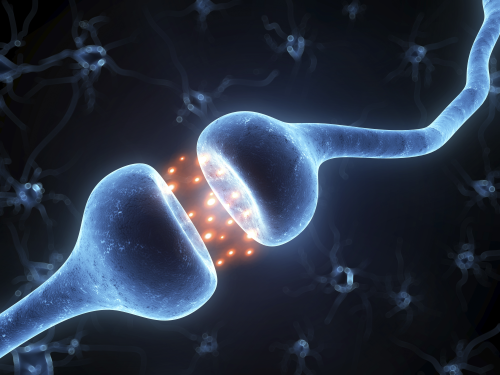
When we form new long-term memories, the connections between our neurons, known as synapses, are strengthened. (Credit: Sciepro/Shutterstock)
Tonegawa is hoping to use this technology to learn more about the biological mechanisms behind Alzheimer’s and potentially treat the disease in its early stages. In several human studies, he says, even before the brain disorder begins to attack the hippocampus, some patients struggle to make new memories. “[The brain] looks normal, but they actually showed impairment,” he adds.
Now, Tonegawa wants to see whether these cognitive glitches in the disease’s formative stages stem from an inability to form new memories, or if patients can make new memories, but not retrieve them. He points to research on earlier stages of Alzheimer’s disease in mouse models that suggests that these memories still form and leave physical traces, but can’t be recalled by natural cues. But when scientists have used artificial methods like optogenetics to reactivate the cells carrying memory engrams, says Tonegawa, the animals were able to remember new experiences perfectly.
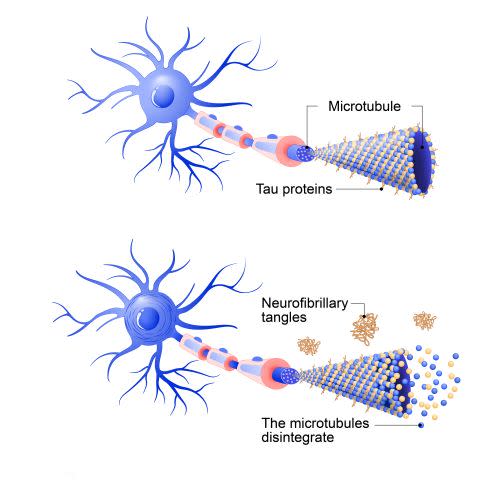
(Credit: Designua/Shutterstock)
“It was only possible to discover something like that by taking advantage of the technology,” he adds. “It really allows us to investigate what is happening during the learning and memory process.”
Imaginary Worlds, Real Memories
The past few decades have also seen more researchers using virtual reality technology in their work. In recent years, Nanthia Suthana, a neuroscientist at UCLA, became one of the first researchers to use virtual reality to study how someone’s brain stores and recalls memories as they navigate a simulated environment.
“Historically, the large majority of [memory studies] have been done with rats and mice running through mazes,” says Suthana. “A lot of what we know about the brain comes from those studies. And, in order for us to translate those and see if they’re really true for humans, we need something to connect between the two.”
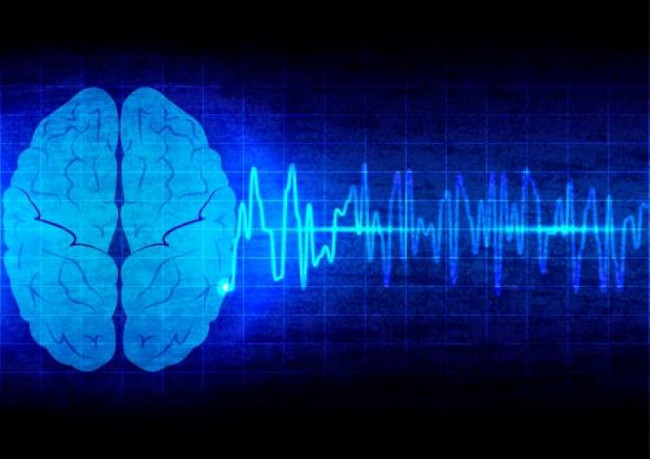
(Credit: Mrspopman1985/Shutterstock)
In two studies currently under peer review, Suthana and her colleagues worked with patients with deep-brain implants for treating epileptic seizures. The researchers put virtual reality headsets on the patients, whose permanent implants enabled the scientists to record brain waves during the experiment. Once the participants donned goggles and motion-capture bodysuits studded with reflective dots to track their movements, they then performed a series of tests on learning, memory and navigation in a simulated environment.
Within the virtual landscape, the patients were asked to walk toward digital yellow cylinders and remember each one’s location. To demonstrate their recall, the participants were asked to repeat their path to each cylinder — now invisible — and press a joystick button when they thought they had arrived at each one. The researchers then downloaded the recording of the patient’s brain waves, analyzing them to see the neural activity associated with memories of space and location.
Specifically, the scientists were focusing on electrical signals in the brain known as theta oscillations, which have been identified in humans during movement. And the research team found that these brain waves were more active throughout the navigation tasks, suggesting that they’re critical building blocks of spatial memory. The scientists theorized that these brain waves may help us visualize and reconstruct our memories as we move about the world.
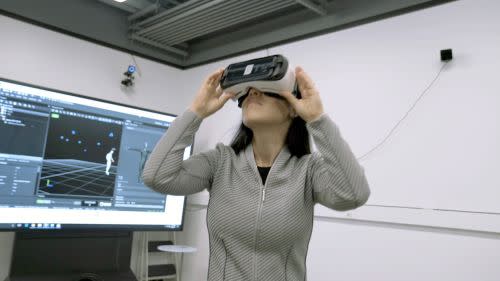
UCLA neuroscientist Nanthia Suthana uses virtual reality to study how our brains store and retrieve memories about movement. (Credit: Jason Cooper)
Suthana is no stranger to the fragility of memory. After her son’s birth, she experienced a short period of amnesia in which she couldn’t remember an entire decade. “I thought I was a graduate student again,” she says. “It’s a really scary and puzzling experience.” Ultimately, she hopes that research like hers can help scientists restore memories lost to trauma and neurological disorders like Alzheimer’s disease.
“The brain is electrical in its language,” she says. “So if we can communicate with the brain, electrically, maybe we can facilitate when things go wrong.”
Fighting Fear
Take a second to think about what you’re afraid of. It might be spiders. Or the threat of a car crash. It may be as basic as not having enough money to pay your rent next month. For many of us, these fears are tied to memories of past experiences.
When we form episodic memories of things that happened to us, three areas of the brain are engaged: the hippocampus, the neocortex and the amygdala. The hippocampus takes the information from our memories and physically encodes it into the connections between neurons. Later, this data is sometimes transferred to the neocortex — the thin tissue that forms the brain’s outer layer — for long-term storage. But it is the amygdala, an almond-shaped mass of brain matter, that injects our memories with emotions like fear.
“If an experience has a strong emotional component, the amygdala will squirt that into the newly forming memory,” says Burnett. “If someone has an active amygdala, they learn to be scared of things.”
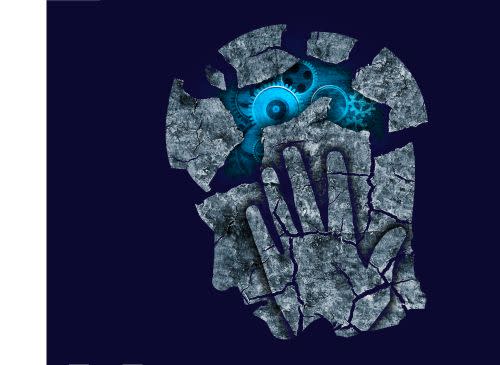
Scientists at the Queensland Brain Institute are studying the neural hardware behind memories of fear and trauma. (Credit: Jiris/Shutterstock)
In recent years, scientists have learned a lot about the hardware in our brains that modulates our responses to fearful memories. At the Queensland Brain Institute in Australia, researchers are recording the electrical activity firing between these three brain regions in mice as they are conditioned to fear a particular sensation or noise.
“You take a neutral stimulus, like a tone or a light, and with that you present the animal with an aversive stimulus, like a foot shock or a loud noise,” says neuroscientist Pankaj Sah, the institute’s director. “And the animal pretty quickly learns that this innocuous stimulus is going to predict this aversive one. Then it forms the memory of it.
“If you do that in rats three or four times today, and come back a year later and present the same tone, that animal remembers that the tone was scary and responds appropriately,” he adds. “You can do the same thing in people.”
That conditioning can be exploited for good, too. If the mouse repeatedly hears that same tone again, but without the shock, then the noise will stop causing the animal to freeze in fear. Eventually, through a process called extinction learning, the pain of the memory fades away. This process is key to behavioral therapies for patients with conditions like PTSD. But despite the effectiveness of these techniques, extinction training doesn’t erase traumatic memories — it just saps some of their strength. If something reminds someone of the original traumatic memory in a new context, even after extinction, it can solidify again, re-forming the link between the trigger and the response. “People who are injecting heroin can learn to not do it,” says Sah. “But when the context changes, or something happens in the environment and it’s not a place where it’s safe anymore, all those memories come back.”

(Credit: Torook/Shutterstock)
Sah thinks that a sharper understanding of why some traumatic memories return after therapy may lead to better treatments for disorders such as PTSD and addiction. In a 2018 Nature Neuroscience study, Sah and his colleagues used optogenetics in rats to identify the circuitry in the brain that controls the return of traumatic memories. By understanding those mechanisms, says Sah, it might be possible to develop new drugs to prevent relapses. “What we’re looking for is a more specific [chemical] compound,” he continues. “That’s how you go about really treating these disorders: understanding the circuits that underpin [them] and the receptors that are involved.”
And thanks to a tidal wave of new tech, Sah says these advances might someday help scientists treat memory disorders the same way that we use drugs to control heart disease. “The whole study of the brain is really undergoing a revolution right now,” he adds. “It’s really a great time to be in neuroscience.”
Alex Orlando is an assistant editor at Discover.


